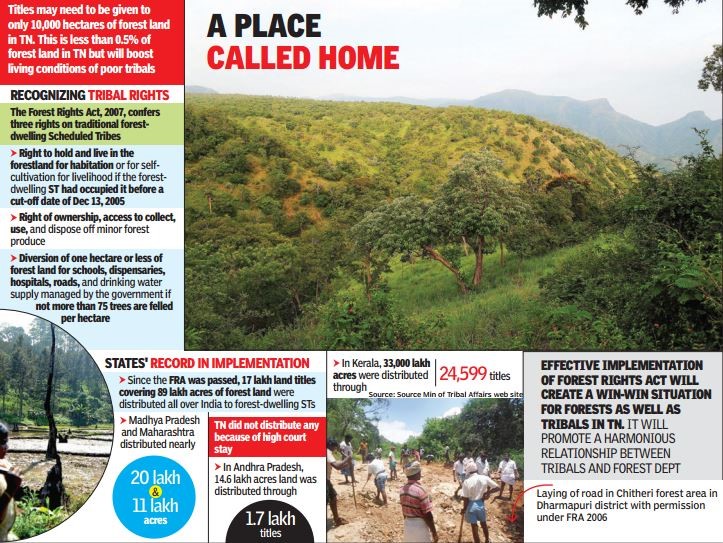[ad_1]

Introduction:
The Forest Rights Act (FRA) has been in existence for 15 years. As on April 30, 2020, the Ministry of Tribal Affairs had received 42,50,602 claims (individual and community), of which titles were distributed to 46% of the applicants.
If the Forest Department’s views are considered, the implementation process is more or less over. But the supporters of tribal rights allege that the Department is overlooking the genuine claims of the tribal people.
Despite the Ministry being the implementing agency, the role of the Forest Department in granting titles is crucial because the lands claimed are under its jurisdiction.
While both sides hold extreme positions, the situation on the ground presents a mixed picture.
Brief Background: About Forest Rights Act 2006:
The symbiotic relationship between forests and forest-dwelling communities found recognition in the National Forest Policy, 1988.
The policy called for the need to associate tribal people in the protection, regeneration and development of forests.
The Scheduled Tribes and Other Traditional Forest Dwellers (Recognition of Forest Rights) Act, 2006, was enacted to protect the marginalised socio-economic class of citizens and balance the right to environment with their right to life and livelihood.
The act identifies four types of rights:
Title rights:
- It gives FDST and OTFD the right to ownership to land farmed by tribals or forest dwellers subject to a maximum of 4 hectares.
- Ownership is only for land that is actually being cultivated by the concerned family and no new lands will be granted.
Use rights:
The rights of the dwellers extend to extracting Minor Forest Produce, grazing areas, to pastoralist routes, etc.
Relief and development rights:
To rehabilitation in case of illegal eviction or forced displacement and to basic amenities, subject to restrictions for forest protection
Forest management rights:
It includes the right to protect, regenerate or conserve or manage any community forest resource which they have been traditionally protecting and conserving for sustainable use.
Issues in implementation:
- The journey of the FRA’s implementation has never been smooth. The Act provides for democratic tenets in the implementation process.
- In the first stage, it requires the constitution of a Forest Rights Committee comprising members from within the village by conducting a Gram Sabha with two-thirds of the members present at the meeting.
- The process was not followed in many places. These committees were mostly constituted by the Panchayat Secretaries upon the directives received from District Magistrates at short notice.
- The nominations for members for the taluk-level and district-level committees were also not transparent.
- The contribution of women to the forest economy is well known. The FRA provides for equal rights in titles issued under the Act for women.
- They have the equitable role at every stage of decision-making. However, on the ground, the women were hardly visible in this regard.
- It was disappointing that in the initial stages of implementation, there was insistence on satellite images as evidence while other admissible proofs were ignored, as happened in Gujarat.
- This resulted in mass rejections of claims by the authorities. It is a different matter that a writ petition filed by the civil society groups in 2011 forced the authorities to look into the matter afresh in the State.
- Further, various welfare and developmental schemes of the Rural Department were not extended everywhere to the tribal people who received documents of land possession under the FRA despite the directives issued by the Ministry to treat them on a par with others.
Declining produce, livelihoods of tribals on forest produce:
- Many tribal areas are witnessing a decline in the quality of forest produce in their vicinity, thus forcing them to look for other sources of livelihood.
- In Chhattisgarh, in many villages, earnings from activities such as collection of tendu leaves for rolling local cigars were affected when there was an influx of labourers from Bihar who were willing to work for low wages.
- Poor market and exploitation by local traders/middlemen were no less demoralising.
- The recognition given to their lands under the FRA gave the tribal people a psychological boost.
- However, they possess lands (including the lands recognised under the FRA) that are small, of poor quality (particularly lands located on hill slopes) and are not very fertile.
- The lack of irrigation facilities forces them to depend only on rainfall. To enhance their income, they migrate to work as construction or road-laying labourers.
- In their opinion, this will continue until the wages earned through any source in the villages matches with the wages in urban areas.
Involvement of NGOs was missing in interior tribal areas:
- Overall, poor awareness levels among the tribal people proved to be a handicap, especially in the scheduled areas which are remotely located.
- To effectively present claims, a fair understanding of the Act and its implementation process is necessary.
- Some NGOs, like in Dang district of Gujarat, made a difference by hand-holding the beneficiaries at every step.
- However, the involvement of NGOs was missing in some interior areas in States like Chhattisgarh where insurgency was affecting the lives of the people.
- Evidence suggests that implementation was better in areas which were fairly close to urban settings or where accessibility was easy.
- In these places, most Central and State government schemes and programmes such as Deendayal Upadhyaya Gram Jyoti Yojana, Janani Shishu Suraksha Karyakram, Mahatma Gandhi National Rural Employment Guarantee Scheme, National Food Security Act, National Health Mission; Pradhan Mantri Awas Yojana; and Pradhan Mantri Gram Sadak Yojana were implemented, empowering the people to assert their positions.
The way forward:
The FRA was never going to be a panacea to address all the issues of the tribal people, but it is important.
- To improve the condition of the tribal people, especially those living in remote areas, there needs to be a push on every possible aspect of their socioeconomic life.
- This can be attained if schemes and programmes already drafted for the tribal people are implemented in letter and spirit across the country.
- With protective laws like the Panchayats (Extension to Scheduled Areas) Act, 1996, in place, it is only a matter of will.
- One way forward could be to induct people who are sensitive to the cause of tribal people in the decision-making process at every stage.
- NGO representatives working in the tribal areas believe that the livelihoods of the locals would improve if horticulture practices are promoted in addition to bamboo and aloe vera plantations with an assured market.
- A popular recommendation is medical and ecotourism along the lines of the Kerala model.
- On the other hand, given the quality of education received by the youth in the remote districts, the possibility of acquiring meaningful jobs remains thin. Those accustomed to urban culture do not feel like going back to their villages.
- Civil society groups, therefore, believe that providing skill-based education with assured jobs on a large scale in proportion to the demand would do wonders in these areas.
Conclusion:
Large-scale awareness and information dissemination campaigns are required at local level informing both tribal and lower-level officials.
The relevant maps and documents should be made available to the Forest rights committee and claimants to simplify the task of the Gram Sabha in identifying and filing claims for individual and community rights.
Providing clarity on the time limit for settling claims the act does not specify any time limit for resolving claims.
In most of the areas, both the officials and beneficiaries are unaware of this fact. Centre should take more proactive role in pushing states to honour a law that could change the lives of millions.
[ad_2]

